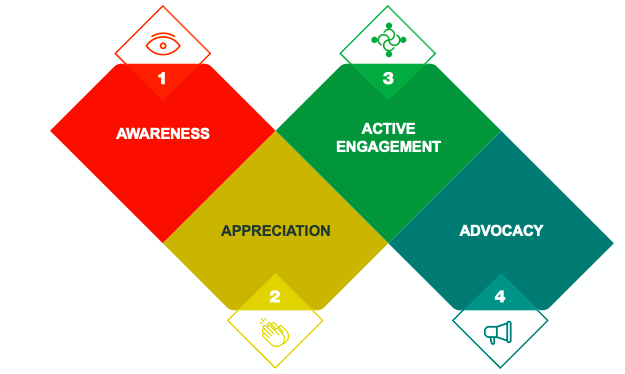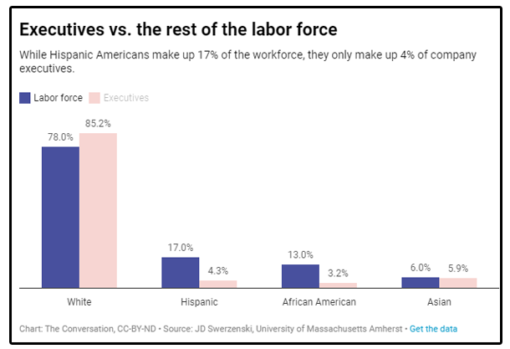Celebrating Hispanic Heritage Month
As Hispanic Heritage Month kicks off, we at Summit are reminded about the astronomical growth of the Latino population in the U.S. and the immense implications it has for Boards and CEOs as they seek to diversify their talent and more closely mirror the markets they serve. The statistics are staggering: between 2000 and 2010, the population of Latinos increased at three times the growth rate of the rest of the country. Latinos are now the largest ethnic minority group in the U.S. workforce at 17% and comprise 21% of the Millennial generation. Today, they account for $1.5 trillion in purchasing power, more than the GDP of Mexico, and are expected to grow at a rate of $100 million a year.
Closing the Gap
Despite this growing consumer bloc, only 4% of executive positions at Fortune 500 companies are held by Latinos according to the Corporate Inclusion Index published by the Hispanic Association on Corporate Responsibility (HACR). Without this representation, companies will be handicapped in terms of fully understanding the unique needs and opportunities presented by this important demographic.
At its extreme, their lack of understanding of this population can lead to harmful stereotypes that disenfranchise those consumers. Take the example of Clorox, who in 2010, published the results of a study that led to “better understand the housekeeping lessons and cleaning routines of Latinas”. In the results, they noted that “cleaning is a rite of passage, taught by [Hispanic] mothers and grandmothers”. The public response to this was incredulous, as both Latinos and non-Latinos alike, expressed their dismay that such a large, well-established brand was blind to the kinds of stereotypes those types of statements promote.
Understanding Latino culture is appreciating that there is no single Latino identity. Latinos aren’t one homogeneous bloc, but rather a diverse tapestry of unique cultures. Subscribing to blanket labels about “Latinos” may simplify someone’s mental model of the world, but would be wholly inaccurate.
More than a Numbers Game
While no leader, or small group of leaders, should bear the responsibility of representing an entire demographic, especially one as diverse as the Latino population, organizations are well served to ensure their leadership ranks represent the markets they serve. In fact, research by the Center for Talent Innovation (CTI) found that teams with one or more members who represent the target end user are 158% more likely to understand that end user and, as a result, innovate more effectively for their needs. However, it is not a mere numbers game…just increasing the representation of Latinos won’t address the issue.
The CTI also found that more than three out of four Latinos expend energy repressing parts of their personas in the workplace. They often downplay who they are, modifying their appearance, their body language, their communication style, and their leadership presence. In other words, they aren’t comfortable fully expressing themselves, or their ideas, and as a result, the potential impact of their contributions is also mitigated. Companies lose out on the valuable insights they can provide, and they never feel fully embraced or accepted by the environments they work in.
Culture Matters
Addressing this requires the intersection of two critical elements: a culture that authentically encourages team members to show up as they are without the fear of being marginalized and leaders with a mindset and the leadership skills to promote and role model this type of culture.
Creating a culture where Latinos, and any underrepresented minority, feel safe to express their individuality and ideas requires leaders who are intentional about creating a psychologically safe environment. Research has found that diverse talent more effectively unleashes their innovative thinking when they:
- Feel welcome and included
- Feel free to share their ideas and opinions
- Are confident their ideas are heard and valued
To achieve such a culture, Summit research has found that developing a truly inclusive leadership style is a journey along four different stages:

Awareness: Leaders at this stage are aware of diversity, equity, and inclusion opportunities. They recognize privileges afforded to some groups and barriers facing other groups. They consider aspects of inclusion and belonging when making decisions.
Attention: These leaders display keen insight into others, their unique circumstances, and their background. They pick up on subtle forms of discrimination and bias and remain open and humble. Additionally, they look for opportunities to learn and educate themselves about people different from them.
Active Engagement: Leaders at this stage actively bring in people from underrepresented groups to be a part of activities and initiatives. They foster a psychologically safe environment where others feel valued and represented.
Advocacy: Comfortable acknowledging and calling out bias; challenges assumptions and outdated practices that perpetuate inequities. Remains resilient during tough conversations and acts in an authentic manner that is aligned with values of equity and inclusion.
Carmen Serrato, Marketing Manager at Meta, summed it nicely by saying, “As a Latina, I find that we have a more challenging time finding mentors in our careers because there are not many leaders we can relate to who understand our unique challenges. To truly increase opportunities for our group, we need active development and mentorship programs that are tailored to helping us succeed but this requires the active participation of non-underrepresented leaders to help champion for underrepresented groups.”
The growth of the Latino market has been astronomical and as companies compete to serve their needs, CEOs and Boards must work diligently to ensure that Latino talent is well represented at all levels. As Sylvia Ann Hewlett, CEO & Founder of the CTI summed up nicely, “If I learned anything from my training as an economist, it’s that numbers speak volumes. And this number’s message is crystal clear: corporate leaders need to build workplaces that attract, engage, and retain top Latino talent, or they will miss out on a great deal of value.”
